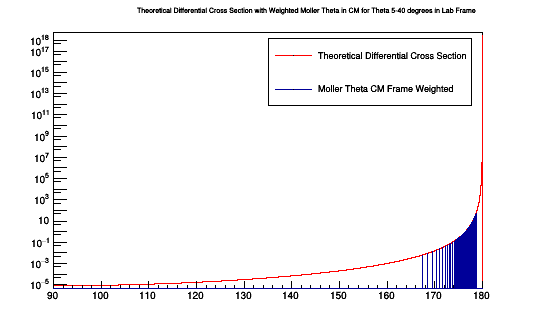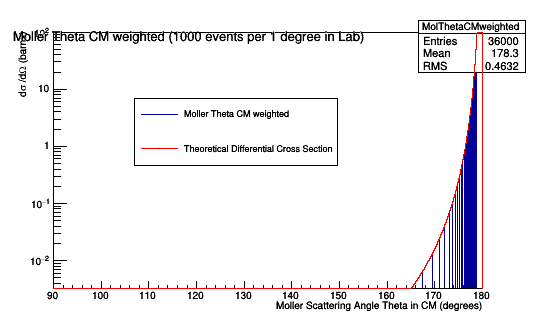Difference between revisions of "DC hits to Moller XSection"
| Line 28: | Line 28: | ||
This sets the lower limit: | This sets the lower limit: | ||
| − | <center><math>\frac{5\deg}{1}\frac{\ | + | <center><math>\frac{5\deg}{1}\frac{\pi radians}{180\deg}=.0872664626 radians</math></center> |
| + | |||
| + | |||
| + | This sets the upper limit: | ||
| + | |||
| + | <center><math>\frac{40\deg}{1}\frac{\pi radians}{180\deg}=.698131700798 radians</math></center> | ||
| + | |||
| + | Taking the difference, | ||
| + | |||
| + | <center><math>.698131700798-.0872664626=.61086523198 radians</math></center> | ||
Revision as of 20:35, 25 October 2016
Examing the CM Frame Theta angles which correspond to Lab frame angles within 5-40 degrees, for only on degree in Phi (0 degrees)
For each degree in Theta in the Lab frame, the correct kinematic variables are written to a LUND file 1000 times. These events are read from the evio file using
The Moller Scattering angle Theta is read from the evio file, and it's weight adjusted by dividing by the number it was multiplied by (1000) to give
From the evio file, a histogram can be constructed that will only record the Moller events which result in hits in the drift chamber. A hit for this setting is the
Plotting the Moller scattering angle Theta in the Center of Mass frame, and adjusting the weight by the number of times the specific angle caused hits. We should recover the Moller differential cross-section as found previously.
Once the validity of the Moller differential cross-section is established, we can transform from the center of mass to the lab frame as shown earlier. Since the detector is in the lab frame, the hits collected will have to be used to compose a histogram for the Moller scattering angle in the lab frame. We can show that the Moller events that register as hits in the lab matches the Moller differential cross-section in the lab.
To associate the hits with the Moller scattering angle theta, the occupancy plots of the drift chamber hits by means of wire numbers and layer must be translated using the physical constraints of the detector. Using the data released for the DC:
DC: Drift Chambers(specs)
This sets the lower limit:
This sets the upper limit:
Taking the difference,

